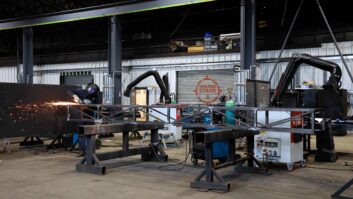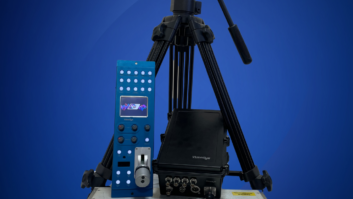NAB News: A UK start-up, Meduza Systems, has used military technology to devise what it claims is the first professional integrated 3D camera capable of shooting 4K, using a design that shouldn’t be made obsolete by new technologies, writes Adrian Pennington.
Speaking to TVB Europe, the CEO of Meduza Systems’ parent company, 3D Visual Enterprises (3DVE), Chris Cary explained the concept behind the system – including its ability to work with a variety of sensors.
The Meduza is being shown for the first time at NAB in Las Vegas and will be released around the time of IBC. It features a single set of electronics and a single set of controls powering two sensors capable, it is claimed, of generating higher frame rates than Sony’s prototype 4K camera – also debuting at NAB.
It is designed to be customizable to the needs of cinematographers, but as yet no cinematographers have road tested it.
There are other integrated 3D cameras, from the likes of Sony, Panasonic, Frontniche and 3D One.
“There are numerous HD cameras out there and some are quite respectable. However by professional we mean good enough to blow up to 15/70mm film or for that matter 4K projection. Certainly, the Panasonic [AG-3DA1] doesn’t even qualify for broadcast TV having been rejected by, among others, Discovery 3D. The Meduza is built from the ground up for the purpose of fully controllable professional use. It is not an amalgam of components from other equipment,” said Cary.
The startling design at the heart of the system is that it does not have a specific sensor. Instead the camera is sensor independent and designed to incorporate newer, higher resolution sensors as they come to market.
“The Meduza is not tied to any sensor,” explained Cary. “There are currently a number of sensors on the market that can capture above 4K, 4K, or slightly under 4K, at different film speeds. We currently support three. We support Aptina, Omnivision, and a third sensor we are launching in June. Unfortunately, we are currently under an NDA [non disclosure agreement] with that vendor, but this sensor is above 4K and will run at a higher frame rate than the Sony 4K (more than 117fps) at full frame.”
Cary contends that the broadcast industry lags behind most others when it comes to digital imaging.
“4K is everywhere, it’s almost old hat at this point,” he said. “There are even 4K sensors in cell phones. The entertainment industry is not a leader; it is in fact a laggard. To imagine that you see cutting-edge tech in the entertainment industry would be inaccurate. What we are trying to do at Meduza is to accept that component technology is moving forward much faster than product development and to integrate emerging technologies within six months of their release, rather than the ‘normal’ 18 to 36 months of the industry.
“With Meduza, in essence, you get a one year jump on everyone else, in a professional package that is never obsolete. Keeping pace with technology is the greater message behind the camera system. It is no longer important who makes the sensor. We don’t make the sensor, we never will. The day of building a camera around a sensor has passed. We believe that capability, flexibility and expandability are now the critical criteria in this field.”
The other interesting aspect is that it allows shooting in 4:3 format at 4K (4096×3072), enabling delivery to 15/70mm giant screens, or general theatrical screens, as well as S3D television viewing.
“The camera format and resolution level means that the image is being acquired at a 1:1 pixel ratio for Giant Screen 15/70mm format and still allows for smaller extraction for traditional cinema and TV,” added Jonathan Kitzen, president of Meduza Systems. “This will also represent massive cost saving in image enhancement and post-production. All other cameras on the market have to blow up to get to this format, the largest in the world, but the Meduza does not have that requirement.”
The product however remains at an early stage of development with input from cinematographers the next step forward.
“What we have now is the physical test bed for a number of technologies we have integrated within the system,” said Cary. “We want to involve not only cinematographers but people from many disciplines including accessory, lens, and support gear manufacturers within our OEM program. Cinematographers can only comment on specifications, but unlike any other camera system there is no ‘fixed’ specification. The Meduza is a customisable platform so that you can easily convert it to [a] specific purpose. That might be changing the sensors to lowlight near IR for night time wildlife, security or military applications, or going for higher speed frame rates for sports. Change the camera to do what it needs to.”
Currently the Meduza is offered with its own matched optics for 2/3-inch and under sensor formats, rebuilt from Schneider glass to the company’s own specifications.
“Schneider makes some wonderful glass, but to get it to completely match at the very high resolutions required for 4K we have had to redesign the entire lens. These will also deliver with the first cameras in the summer as a set of six matched primes. The next generation will be all custom glass for the beyond 4K series.”
The production model has an inter-axial of 38mm to 100mm without a mirror and with the mirror module it will perform 0-65mm. A mini mirror rig, devised by the company, is expected in the autumn.
3DVE was established to provide the resources for this development project. Marketing and sales will be managed from the UK with a local office in the US.
The technical team, led by Kitzen, comes primarily from the defence industry with the majority of development so far occurring in the US.
“You wouldn’t be able to shoot down a plane with a heat seeking missile, watch a 100G crash happen without the lens cracking, see a particle beam weapon fire, or see through a periscope without the contributions of our development team,” claimed Cary.
Recording is made side by side as one combined output, but Cary says this can be altered to two discrete channels as needed. Output is L/R/Stereo and also full wireless via tablet devices enabling stereo checks using off-the-shelf iOS or Android packages. It weighs under 7kg.






